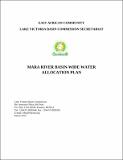| dc.description.abstract | The Mara River Basin (MRB) is an important hydrologic system that not only serves the bordering countries of Kenya and Tanzania, but also exists as a valuable input to Lake Victoria, the world’s second largest freshwater lake which forms the headwaters of the Nile River. Growing water demands and unsustainable use of natural resources within the Mara River Basin (MRB) is placing an increasing strain on the water resources and threatening the livelihood of the many populations that rely on the Mara River as their sole source of water. Water quantity is a major concern within the Mara River Basin (MRB), especially during the dry season when the threat of drought is high. Water of a desired quality is often scarce, and has to be carefully allocated to different uses among them human consumption, sanitation, food production, industrial use, energy production among others. The allocation process has to be carried out in a manner that achieves economic efficiency, social equity and environmental sustainability. As such, the prevailing system of uncoordinated water resources management in the Mara River basin (MRB) cannot sustain the ever-increasing water needs of the various expanding water use sectors. An all inclusive water allocation plan (WAP) therefore makes trade-offs between the priorities of various stakeholders, economic returns and profitability, reliability of water supply, equity, and ecosystem sustainability. The main purpose of this Mara River Basin-wide Water Allocation Plan (MRB-WAP) is to match or balance the demand for Mara River water with its availability, through an efficient water allocation arrangements involving a large number of conflicting water uses including; human/domestic, hydropower generation, livestock, irrigation, wildlife, tourism, mining and the environment (e.g. instream flow requirements) without forgetting the proper management of the catchment and ecosystem integrity This necessitates a strategy that can be used to integrate the various sectoral needs against the available water resources in order to attain both economic and ecological sustainability. Current indications are that the Mara River is highly vulnerable as it is reported to have during some drought period attained dangerously low levels triggering massive deaths of the bigger animals such as hippos. The long term sustainability of the Mara River and indeed many other rivers feeding the Lake Victoria are at a risk of completely drying up. This would threaten the lives of communities, wildlife, livestock as well as aquatic life, and also interfere with economic activities on which the basin inhabitants rely | en_US |

